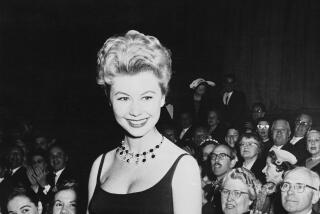Finding Your Inner Jackie : A penetrating study of our relationship to fame : JACKIE UNDER MY SKIN: Interpreting an Icon, <i> By Wayne Koestenbaum (Farrar, Straus & Giroux: $21; 285 pp.)</i>
Thank God for gay men. True, those gay speech patterns can be a little annoying, and the earring business is way overdone, but who else would have the time and inclination to write a book about the way a famous woman is worshiped by her fans and what it all means? Only a gay man. No, I take that back. Only a gay man or Norman Mailer.
But whereas Mailerâs takes on Marilyn Monroe and Madonna sound like the rumblings of a bear who is awakening after a long sleep and discovering things everyone else had known for years, Wayne Koestenbaumâs explanation of the Jackie O phenomenon, âJackie Under My Skin: Interpreting an Iconâ is as fresh and thought-provoking as they come, providing, of course, that you accept the premise that the pathetic obsessions of fans, the endless adoration, the seeking after even more photos, stories, ephemera, is a worthy subject of contemplation. I sure do.
Wayne Koestenbaum is the man who wrote âThe Queenâs Throat,â a study of the âopera queen.â An opera queen is one of the major archetypes of the gay world, and you see them in droves at any opera performance, listening in rapture during the singing itself, then cattily criticizing the diva during intermission, not just for her interpretation of the role but for her costumes, hairstyle, weight gain and personal life. Terrence McNally wrote a very funny play about them (âThe Lisbon Traviataâ) but it is Koestenbaumâs book that instantly became the last word on the subject. In it he manages to pinpoint what is significant about the gay sensibility, where itâs coming from, and how opera so perfectly accommodates it.
There isnât a chapter about Jackie and homosexuals in Koestenbaumâs new book--although perhaps there should have been--but itâs about the only subject he skips. He discusses getting in touch with your âinner Jackie,â the close ties between Jackie and Chiclets, and Jackie as âDurga, Goddess of Power.â Let me stress at this point, though, that his technique is not humor, nor satire, but rather the most painstaking and subtle intellectual analysis. The key here is the subtitle: âInterpreting an Icon.â
Thatâs exactly what he does, in the language and tone of a very bright college professor who doesnât care what the rest of the faculty thinks.
Be forewarned that there is nothing about the âreal Jackieâ in this book. Koestenbaum is concerned instead with icon Jackie or Mythic Jackie. If I understand him correctly, and I am extremely glad that I merely have to review this book, not take a test on it, she became âsublimeâ (used here in the philosophical, Edmund Burkeian sense of an object so powerful that it produces astonishment) when her husband was murdered at her side. At that moment, probably the most dramatic of the century, our identification with her was so intense that she metaphorically entered every pore of our collective body and was forever after âunder our skin.â Her virtual silence from then on, which we both admired and resented, assured her elevation to icon-hood. She became a shimmering surface onto which we could, and did, project anything. She was both a saint and public sinner, the ideal mother and the hateful stepmother, a greedy bitch and a patroness of the arts, a great beauty and finally a dying cancer victim. Like the Simpson trial, she contains everything.
Koestenbaum has obviously spent years dreaming up this book, and on many levels it is as much a very funny portrait of the mad obsession of the fan as it is about Jackie. This makes for some strange observations, oddball-sounding at first, though on reflection they contain a great deal of truth. Of her large face and hairdo he notes, âItâs easier to lose yourself while adoring a wide head.â About the death of her first husband: âA living woman next to a dead man (a Pieta) is a uniquely satisfying, if horrifying image to contemplate, because the two have been brought to an even level: The man cannot rule now, cannot move mountains, cannot cure lepers. It is the womanâs turn to be heroic, to incite worship, and to rule.â On the way she validates shopping: âJackie has turned places of commerce into shrines. Stores (Bloomingdaleâs for example) are now places where Jackie once experienced desire. . . . To this day, Jackie blesses purchases: âJust keep on with your shopping,â her image seems to whisper.â I wish there had been more about Jackie and shopping. After all, among her many other accomplishments, she experienced every shopperâs dream come true, i.e., marriage to a Greek shipping tycoon.
But then, I wish there had been more about everything. So taken was I with this odd book, so completely drawn into Koestenbaumâs camp, so to speak, that I actually made a pilgrimage--there is no other word--to the San Ysidro Ranch in Montecito, the bucolic hideaway resort in Montecito where Jackie and J.F.K spent their honeymoon. After some covert research and sneaking around, I managed to find the bungalow they occupied. I guess I could have peeked in the windows but just to stand there and look at it was enough. In fact, it was too much. The thoughts and images it conjured up were just too overwhelming and I had to turn away, panting heavily, overcome by the immense power of the 20th Centuryâs greatest icon.
More to Read
The biggest entertainment stories
Get our big stories about Hollywood, film, television, music, arts, culture and more right in your inbox as soon as they publish.
You may occasionally receive promotional content from the Los Angeles Times.










